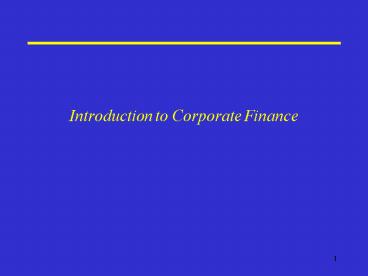Introduction to Corporate Finance - PowerPoint PPT Presentation
1 / 14
Title:
Introduction to Corporate Finance
Description:
Jeff Fettig, CEO of Whirlpool, announced an offer to buy Maytag for $1.43 ... possible increase in Whirlpool sales as a result of new product mix. 4 ... – PowerPoint PPT presentation
Number of Views:297
Avg rating:3.0/5.0
Title: Introduction to Corporate Finance
1
Introduction to Corporate Finance
2
Financial decision making
- July 2005
- Jeff Fettig, CEO of Whirlpool, announced an offer
to buy Maytag for 1.43 billion in cash and stock - Why a mix of cash and stock?
- Mark Hurd, CEO of HP, announced that HP would cut
14,500 jobs (10 of employees) over next 18
months - Tom Gahan, CEO of Deutsche Bank, authorized
traders to buy and sell 600 billion worth of the
largest US stocks in a strategy referred to as
stock index arbitrage - How did these people decide that these were good
decisions for their firms?
3
Financial decision making
- Do the financial benefits outweigh the costs?
- Comparing costs and benefits is complicated
because they occur at different points in time. - Whirlpool/Maytag decision
- Costs
- Whirlpool ended up paying 1.73 billion for Maytag
- incurred ongoing Maytag costs
- incurred costs of restructuring 2 firms into 1
- Benefits
- total cost reduction
- future sales of Maytag products
- possible increase in Whirlpool sales as a result
of new product mix
4
Decisions of financial managers
- Balance-sheet view of the firm
Liquidity Decisions
Capital Structure or Financing Decisions
Capital Budgeting or Investment Decisions
Risk Management Decisions
5
Our primary objective in FINC850
- Study how corporations make financial decisions
that further the firms objective - To do so,
- we will examine how cash flows and securities are
valued and used (the RHS of the balance sheet) - we will examine the framework in which investment
decisions are valued (the LHS of balance sheet), - So, what is the objective of any business?
6
What should be the goal of a corporation?
- Maximize current profits?
- Ensure survival of the organization?
- Maximize income available to employees?
- Provide stable employment and be a good corporate
citizen? - Maximize shareholder value
- This eliminates potential failings of above goals
7
Maximizing shareholder value vs. profits
- Shareholder value is the present (discounted)
worth of - Current-period profits and
- Anticipated future profits, in excess of capital
investment - Maximizing shareholder wealth considers the
tradeoffs between current and future profits, and
the risk of obtaining their profits.
8
Shareholders vs. Stakeholders
- Does maximizing shareholder wealth imply taking
extreme positions toward other claimants? Does
such a firm - Hire employees in the day labor market, with
absolutely no implication of continued
employment? - Refuse to ever make charitable contributions?
- Try to get as much profit as possible in every
customer transaction? - Maximizing shareholder wealth requires a careful
balancing of interests
9
How to create shareholder value?
- Investment and production decisions should
ultimately stay focused on satisfying consumer
needs and wants - If managers do not focus on efficient employment
of assets - See market for corporate control
- See bankruptcy listings
- How do we know if managers do a good job?
- See stock prices (assumes a reasonably efficient
market) - See audited financial reports
10
CEOs typically talk the talk
- As businessmen and businesswomen, we should
never forget that the best way for us to serve
all our stakeholders not just our shareholders,
but our fellow employees, our business partners,
and our communities is by creating value over
time for those who have hired us. - Roberto C. Goizueta, CEO, Coca-Cola, Inc.
11
Primary objective of financial manager
- Assure all decisions improve and/or protect
shareholder value - To help us, we need to address at least the
following - How are cash flows valued?
- Which cash flows should we value?
- On what grounds do we base investment decisions?
- How are financial securities valued?
- How do we measure and reduce risk?
12
We will build a framework
- for valuing projects and the securities used to
finance and protect investments - First principle of valuation time is money.
13
First principle of valuation
- The value of an asset is the present worth of all
future cash flows expected to accrue to the owner - Since cash flows are generally uncertain, the
value at any point in time depends on the current
best estimate of future cash flows, and the
degree of uncertainty. - Asset values change in response to new
information about the current best estimate
and/or degree of uncertainty.
14
Examples applying the first principle
- Bond value
- Discounted value of promised future
- principal and interest payments
- Stock value
- Discounted value of expected future
- dividends and capital gains.
- Option value
- Discounted value of expected future
- payoffs































